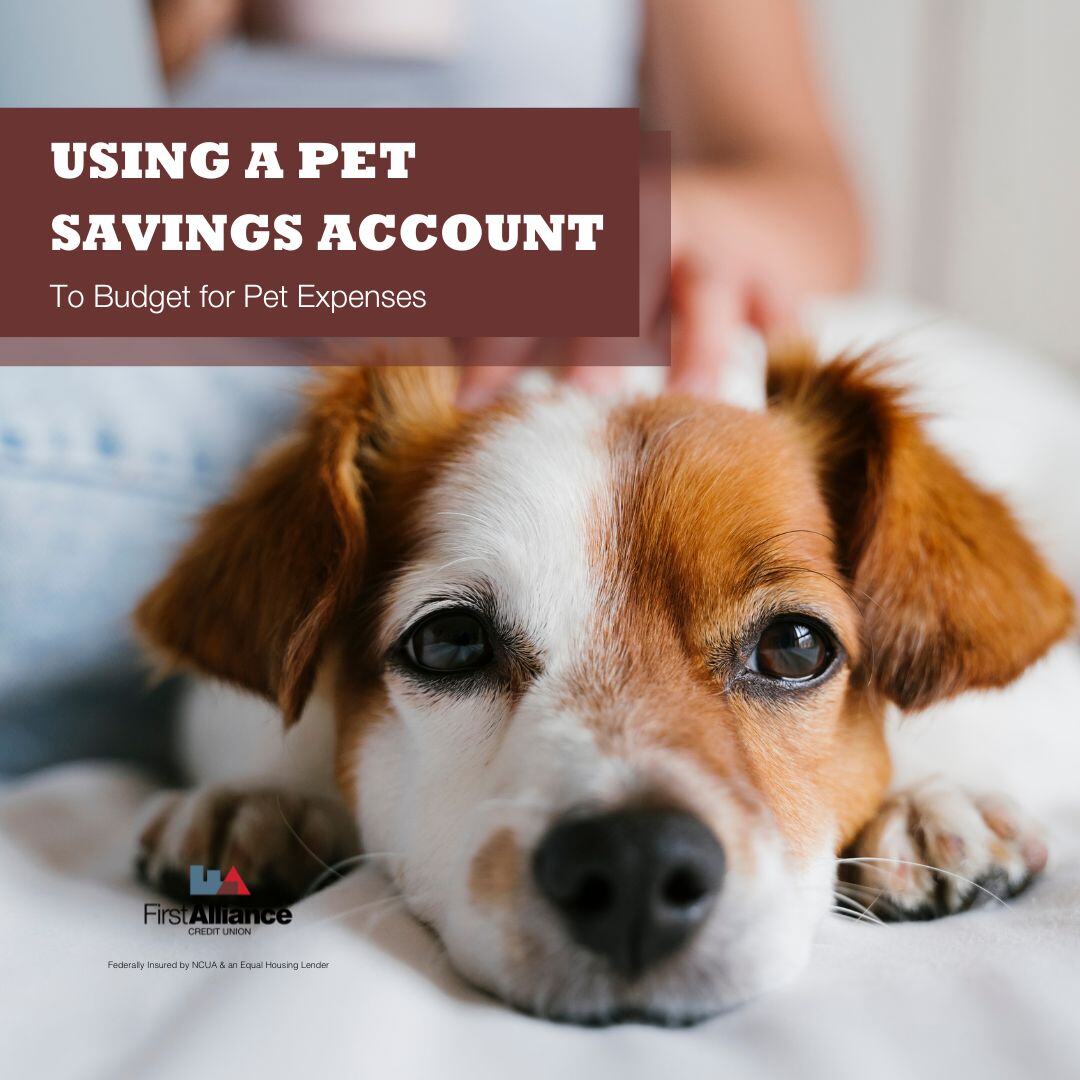Why Every Pet Parent Needs a Pet Savings Account
We all know that our pets are more than just animals—they’re family. But like any family member, they come with their own set of costs, especially as...
5 min read
 Jenna Taubel
:
May 31, 2019 11:22:35 AM
Jenna Taubel
:
May 31, 2019 11:22:35 AM

How do you plan and budget for your pet expenses? Maybe you use your credit card or have pet insurance to help pay for some of the costs as they crop up, but using a pet savings account will actually help you get ahead of the costs related to pet ownership.

Our pets are no doubt an important part of the family. Whether you’re a cat lover, dog lover, or a lizard lover, at some point your pet will probably require a visit to the vet. Even annual exams, vaccinations, and routine heart worm prevention can become quite costly when you add it all up for the year. If you’re not planning ahead for these types of expenses it can really hit your budget hard, especially when it's from an unexpected injury or illness.
While there are excellent options these days for pet insurance, it still isn’t typically going to cover all the expense related to your pet’s health needs. Most pet insurance providers don’t cover routine exams and care, and you still have to meet deductibles. This is why it’s important to also have a plan to cover these expenses, like opening a pet savings account.

A pet savings account is a special type of savings account available at some credit unions and banks to help you plan and save specifically for your pet related expenses. What makes a pet savings account different from a regular savings account is that pet savings accounts typically offer special benefits like higher interest rates, discounts on pet insurance or others may donate to a local animal shelter. Think of it as a your pet's personal banking account!
Most people consider using pet savings account to cover their pet’s health care costs; however a pet savings account can really be used help you plan and save for any pet related expenses, such as:
Pet savings accounts can be used to help you plan for costs for your pets, large or small. However, since most people use this type of savings account to plan for their pet’s health care related expenses, that’s what I will focus on with the examples in this article. But you could easily include any additional pet related costs in as you see fit to meet your budgeting needs.
If you’re considering opening a pet savings account you’ll want to think about the expenses you’re planning to cover with the account ahead of time to ensure you’re getting the most benefit from the account. To simplify this process for you, I’ve broken it down into three easy steps to follow:

First, you will need to know on average how much money you’re spending annually on regular veterinary care. This way you know how much you should be saving into this account for it to be beneficial to you.
As an example, I have two large dogs, Juno, a Newfoundland mix, and Merlin, a lab-pit mix. When I recently took them to the vet for their annual exams it cost me about $650. This vet bill included the several different charges:
Now, when you add in the costs of their heart worm preventive and flea and tick preventative for the entire year that’s another $350. Your pet may have other recurring expenses to consider, but for me, I will need to be saving about $1,000 annually to cover these expenses. If you have smaller pets or only one pet, you’re costs will likely be less, and if you have more pets your costs will likely be higher.
Additionally, if you also cover your pets with a pet health insurance plan you may want to build into your initial savings goal the cost of your insurance deductible too. This way if an unexpected injury or illness does occur you’ve already planned ahead and will have the funds you’ll need to cover the upfront costs. Using myself as an example again, the pet insurance plan I use to cover my two dogs through Healthy Paws requires a $500 deductible each, or another $1,000.
If you don’t have pet health insurance coverage it would also be a very good idea to plan on saving up more than just want is need to cover your known annual expenses. This will help pad your pet saving account with extra funds in case an emergency does arise. You don’t want to be stuck having to think about finances when your pet’s life is on the line, trust me I’ve been there and it is heart wrenching. Plan ahead!

Once you’ve determined how much you need to save in total for your pet’s veterinary costs for the year, the next step is to determine how much you need to put into your pet savings account each month to cover these expenses. So for myself, I’d take the $2,000 that I determined earlier, and divide that by 12 to determine the amount I need to save monthly, which is about $167.
Again, the specific amount you need to save could be higher or lower than my example depending upon your pet’s health needs, size, breed, or if you have pet insurance to consider. Larger dogs tend to have higher costs than smaller dogs and cats, and for you lizard lovers, I’m really not sure what health costs are involved with taking care of a lizard, but follow the steps I’ve given you and I’m confident you’ll figure it out.

The final step is to actually start putting money into your pet savings account. I suggest setting up recurring automatic transfers into your pet savings account; this makes it effortless to save money each month for your pet’s expenses. Each financial institution will have different options for setting up recurring automatic transfers.
If the money you’re transferring into your pet savings account is coming from an account at the same financial institution you should be able to do this yourself within your online banking account. However, if you are planning to transfer money from an account at a different financial institution, you may need to call your financial institution to have them help you set up the recurring transfer via an ACH.
If you choose to make manual transfers into your pet account make sure you’re actually going to do it. If you’re not setting aside the funds as you’ve planned you’ll end up short when it comes time for the next vet visit.
Caring for your pet shouldn’t be a financial strain. By setting up a pet savings account, you’re giving yourself the peace of mind that comes from being prepared for both routine and unexpected expenses. Whether it's for regular check-ups or those surprise vet visits, having a dedicated savings plan ensures that your pet's needs are covered without disrupting your budget. Start small, be consistent, and let this simple financial tool make a big difference in your and your pet’s life. After all, our furry, scaly, or feathered friends deserve the best care, and with a pet savings account, you’ll be ready to give it to them.

We all know that our pets are more than just animals—they’re family. But like any family member, they come with their own set of costs, especially as...

If you’ve ever owned a pet, you know the joy and companionship they can provide. You probably also know about the responsibility of owning a pet, a...

Checking accounts are a type of banking account used for everyday expenses. They’re good for everyday uses because there isn’t a limit to how often...